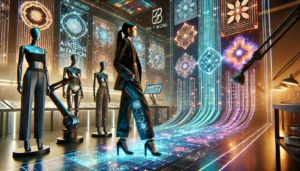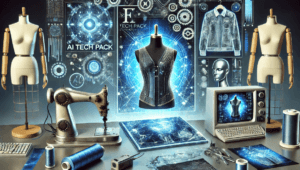Let’s delve into the exciting ways the Internet of Things is transforming fashion from concept to closet.
The Internet of Things (IoT) connects everyday objects to the web, enabling them to collect data and communicate. This technology is set to revolutionize the fashion world, reshaping what we wear, how it’s made and experienced.
Through the Internet of Things, everyday electronic devices, ranging from coffee makers to medical devices, are interconnected via the Internet, allowing them to communicate and function autonomously without human intervention, improving user convenience.
The IoT can advance the fusion between fashion and technology. Smart clothing can adapt to the weather, monitor your well-being, and match colors to your mood. Beyond garments, IoT can enhance transparent supply chains with ethical practices and reduced waste. This tech holds the potential to improve sustainability and personalization in the fashion industry.
Smart Clothes That Adapt to You
Imagine having a wardrobe that acts as your personal assistant. Well, IoT-powered smart clothes kind of are, enhancing your life in ways we didn’t think possible.
Workout clothes or personal coaches? By now, most of us know about step-counting wearables; now think yoga pants that analyze your poses, or running jackets that sense your rising body temperature and adjust ventilation. This will be the future.
Where fashion meets health: Garments and wearables powered by the IoT can help you stay healthy by analyzing physiological data and providing early alerts for health issues. For people with chronic conditions, this real-time data can be life-changing. Some of these applications involve monitoring vital signs, stress levels, sleeping patterns, and even potential cancer detection.
Your personal style guru: Ever wish your closet could suggest outfits? Wish no more. With IoT and AI, experiences like smart mirrors and apps analyzing your wardrobe, matching it to your body type and style and recommending clothing combinations can become our daily routine. We all want that Cher Horowitz in Clueless experience, right?
With all these personalized experiences, privacy is key. Brands must prioritize transparency and adopt a data ethics approach to collect and use fashionistas’ information. Consider this when considering who to trust in your stylistic journey.
Revolutionizing Fashion’s Supply Chain
From design to distribution, IoT brings transparency and efficiency in garments’ journey.
Tracking: RFID (radio-frequency identification) tags and sensors track inventory, ensuring items are always available without overproduction.
Quality Control: In factories, IoT monitors machinery for efficient maintenance, reducing waste and improving quality.
Consumer Insight: Fashion marketing strategies are becoming more targeted and effective with real-time consumer insights thanks to IoT tech.
A Shopping Experience Like Never Before
With the IoT, shopping is evolving into an ethical, personalized adventure.
- Mirror Mirror On the Wall…: While we can’t have magic mirrors, we already have smart ones. Some brands have implemented smart mirrors that use augmented reality for virtual clothing try-ons, saving clients the process of stepping into a fitting room and all that entails. You can even create outfits, layer on accessories and get fashion feedback from an AI stylist.
- Your Personal AI Fashion Advisor: Fashion AI applications are transforming how brands engage with consumers, creating seamless interactive shopping experiences. With consent to use your data, AI assistants will combine your purchase history, sensor data, style, and other preferences to recommend outfits and hidden gems you overlooked.
- Ads Made for Your Desires: IoT makes ad-making very precise, even creepily precise. This tech allows for the identification and promotion of items you’ve lingered over but didn’t buy. You know when you keep seeing the same pair of jeans you saw once pop up on all digital channels? You can thank IoT.
Combatting Counterfeits with Digital Certainty
It’s no secret that the world of luxury fashion is a minefield for knockoffs, whether offered to willing or unsuspecting shippers and costing brands billions, nonetheless. Now, brands are embracing IoT to fight counterfeiters.
- Secret Tags: When knockoffs look identical to the real ones, what can we do to tell them apart? IoT allows brands to embed almost invisible tags holding a unique digital fingerprint. Like a high-tech certificate for your bag. These tags can be scanned with a phone and reveal the product’s history to prove its authenticity.
- Harnessing NFTs potential: As The F* Word knows, NFTs can act as digital certificates of ownership and authenticity for both physical and digital garments. This way, blockchain technology can enhance transparency in the industry.
- Protecting Brands and Buyers: Counterfeiting is both a headache for fashion houses and erodes consumer trust. IoT authentication empowers shoppers to know and trust what they’re buying, fostering brand loyalty and confidence in the market.
The Ethical Imperative
IoT’s impact goes beyond style and luxury fashion, all the way to ethics.
- Eyes Inside Factories: Sensors can monitor conditions to ensure workers are treated fairly, like temperature, humidity and even noise levels. This data helps track potential labor law abuses and ensures workers manufacturing clothing are treated fairly.
- Tracing The Thread: IoT tags, through blockchain technology, also track every step of a garment’s life, from where it was sourced, whether it was sustainable, how it was distributed, etc. Shoppers will see its history by scanning a QR code and will be able to make informed choices based on their values.
- Empowered Consumers, Motivated Brands: With IoT, customers can know all about their clothes and feel empowered to demand ethical practices, as well as to make decisions about brands. This transparency drives conscious consumerism and motivates brands to act accordingly.
FAQs:
1. What is IoT in the fashion industry?
The Internet of Things (IoT) in fashion connects garments, devices, and supply chains to the internet, enabling data collection, communication, and automation. This technology enhances personalization, sustainability, and efficiency throughout the fashion journey.
2. How does IoT enable smart clothing?
IoT powers smart garments that adapt to individual needs, such as:
- Monitoring health metrics like vital signs, stress levels, and sleep patterns.
- Adjusting to environmental conditions (e.g., cooling when it’s hot).
- Suggesting outfits based on user preferences via smart mirrors and wardrobe apps.
3. Can IoT improve the supply chain in fashion?
Yes, IoT revolutionizes the supply chain by:
- Using RFID tags and sensors to track inventory and prevent overproduction.
- Ensuring machinery in factories operates efficiently to reduce waste.
- Providing real-time consumer insights to improve marketing strategies.
4. What are IoT-enabled smart mirrors?
Smart mirrors use augmented reality to offer virtual try-ons, allowing shoppers to see how clothes fit without physically wearing them. They also provide outfit suggestions and layering options, enhancing the shopping experience.
5. How does IoT combat counterfeit fashion items?
IoT fights counterfeits by:
- Embedding invisible digital tags in products to prove authenticity.
- Using blockchain and NFTs as certificates of ownership for digital and physical garments.
- Empowering buyers to verify product history and authenticity with a smartphone.
6. How does IoT promote ethical fashion practices?
IoT ensures ethical practices through:
- Monitoring factory conditions (e.g., temperature, noise) to prevent labor law violations.
- Using blockchain to track a garment’s entire life cycle, from sourcing to distribution.
- Providing consumers with transparency about the origins and sustainability of their purchases.
The future of fashion is undeniably connected. Explore it with us through our blogs and follow us on social media for the latest updates on trends!


